
Revolutionary physical instrument designed to upgrade or replace the conventional resistance decade box with keypad and USB-COM Port
Watch our HD/4K QR10 test video on Youtube or Bilibili.
Story
A resistor is to electronics is what a brick to building.
The resistance substitution (decade) box, which can output desired resistance values, has been invented for more than a century. However, little has changed for the past few decades – it is still expensive, cumbersome, requires maintenance and have to manual dial-in settings via mechanical switches.
It’s time for a change.
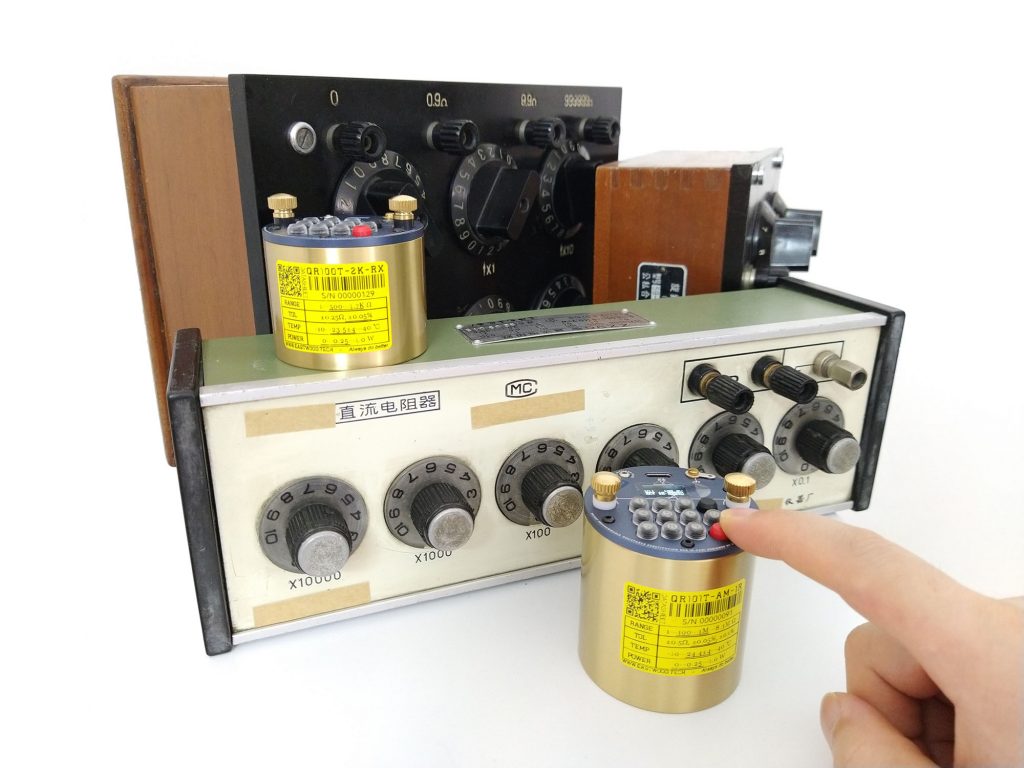
QR10 the Tiny Giant
Only of the size smaller than an adult’s fist, QR10 – the new generation resistance substitution box designed by Eastwood Instruments – has the following advantages compare to its conventional counterpart:
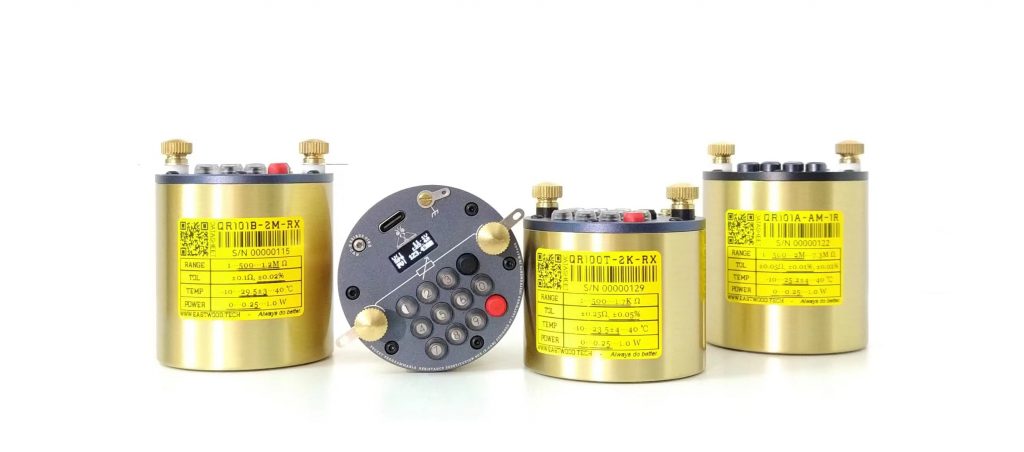
- Electronically controllable switch – Replacing the mechanical switches (greasy brush, open to air) with relays (Au-Ag alloy contact, sealed in relay housing).
- Modern user interface – Replacing the rotary switches with a keypad for setting and mini OLED for displaying more info. which is non-existent in the the conventional resistance box. On the main page, QR10 displays Step-point (SP), resistance Process Value (PV) and max voltage allowed (U<) of PV.
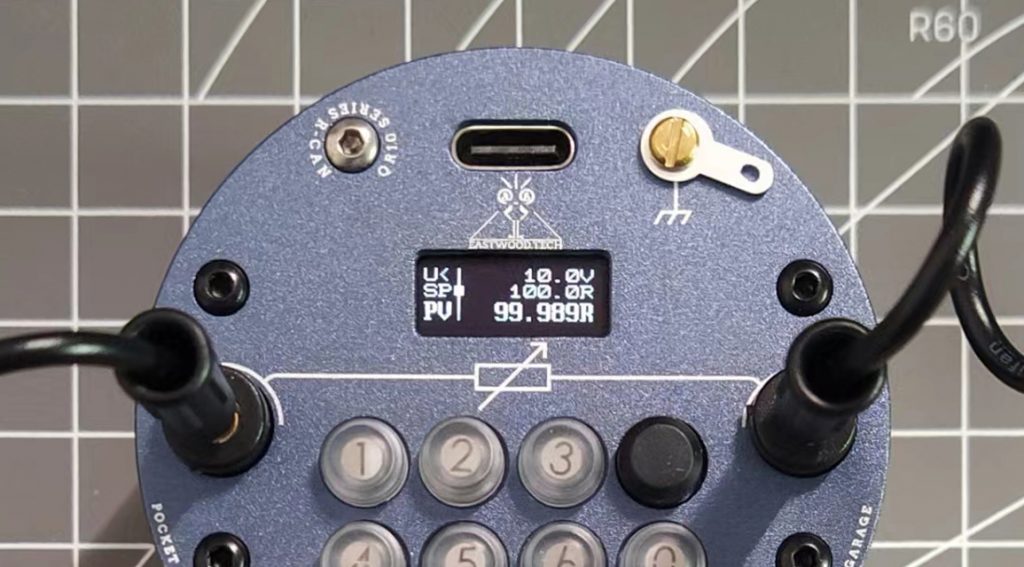
- Plug-and-play USB-Serial interface – The USB-COM serial port supports any free/open source serial software. Besides, the ASCII type AT style commands make it friendly for human beings. Engineers are more aware of the importance of communication interfaces to an instrument, which makes it suitable for advanced applications such as data acquisition and auto-tests, for example, sensor simulation and sensor auto calibration.

- Wider operating temperature range – QR10 can be operated in temperatures ranging from -10 °C to 40 °C.
- Safety output limiter – User-defined minimum output limit to avoid possible overload damage.
- No residual resistance – Every mΩ within the output path is countered in PV and considered in given tolerance.
- Electrical isolation – The control circuit is completely isolated with the output path.
- Low-energy consumption design – With the latching relay we selected and the low-power consumption control method, QR10 can last at least 12 hours @ 1 Hz operating frequency. Moreover, latching relay also helps to decrease output temperature drift since it generates negligible heat compared to its non-latching counterpart.
- Portable in your pocket – QR100: 5.5 cm (OD) x 5.5 cm (H); QR101: 5.5 cm (OD) x 7.0 cm (H), probably smaller than your fist.
- Charging via USB type-C port – There is a 300 mAh rechargeable Li-Polymer battery with 500+ charge/discharge cycle life.
- Enabled user field calibration – it’s a bonus feature. With this feature, users can improve the instrument accuracy at particular temperature for special applications, or as annual calibration.
- Affordable price for everyone – The Kickstarter special price (30% off) is only 10% ~ 20% of its competitor’s.
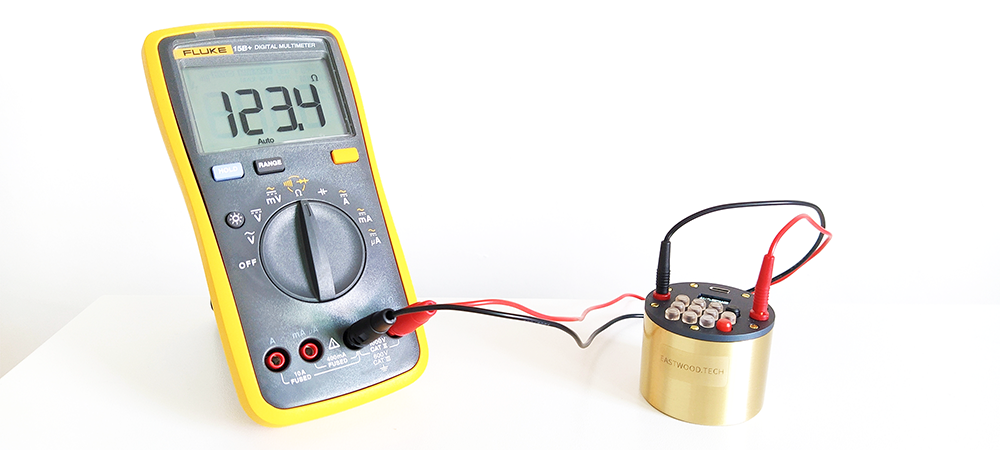
The table below summarizes the basic properties of resistance substitution box.
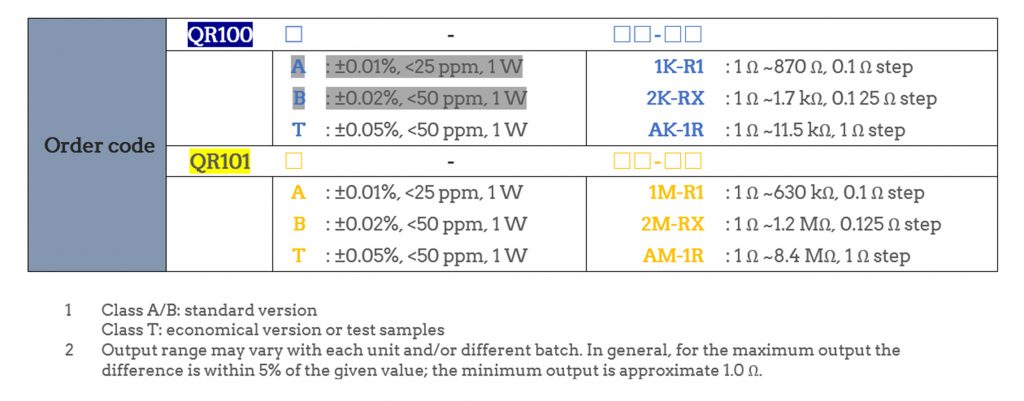
Note-1: In this campaign we choose the 0.125 Ω steps version as preferred type. Considering the various requirements, backers can also select “add-ons” to convert 0.125 Ω steps to other steps.
Note-2: To avoid too many combinations, we decided not to sell QR100A and QR100B.
For more details, please refer to QR10 specification.

±0.05% Tolerance: A Piece of Cake
To increase accuracy, QR10 chooses the approach of calibration.

Thanks to our advanced calibration method adopted in QR10, a rough calibration can easily result in ±0.05% (T class) tolerance; while a delicate calibration and/or higher grade base resistors can narrow down the error significantly to ±0.02% (B class) and ±0.01% (A class).
As a bonus, all the types allow users to do calibration themselves. All they need are just a trustworthy reference meter and an USB type-C cable (See details on QR10 users manual).
How does It Work?
Users especially engineers and students, may be interested in the mechanism of this instrument. QR10 is based on the “Relay-Resistor” network topology, a method that can generate REAL resistor which could be applied in any electronic circuits without limitation.
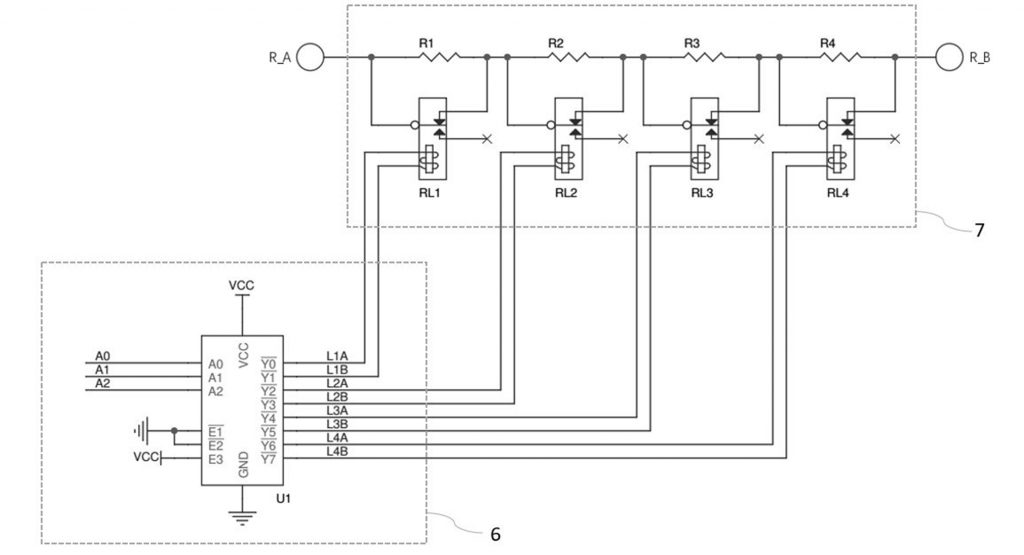
By controlling the status of relays RL1~RL4 illustrated above, base resistors R1~R4 can be “switched in” or “switched out” the output path, while the MCU deals with the Setpoint (SP) to figure out a best combination of relay status for relay coil driver U1.
Being Compact & “Q”
Although performance defines the value of an instrument, compactness will bring many benefits in field application. We prefer the golden brass cup (housing) so much that we decided to constrain the rest of the part at the very beginning. Unsurprisingly, it presents plenty of challenges.

Being able to tuck in a 300 mAh battery, 6 PCBs, 12 buttons, a lid with 0.54″ OLED and two dozen relays and base resistors within a Φ55 mm cup, and being compatible to both QR100 and QR101 (QR101 has an additional layer), with trial, error and inspiration, we eventually came out with a solution that not only meets the requirements, but also can minimize the soldering workload.
To see the actual product inside, click here to watch the third-party teardown video (Edition 2).
Word of Mouth
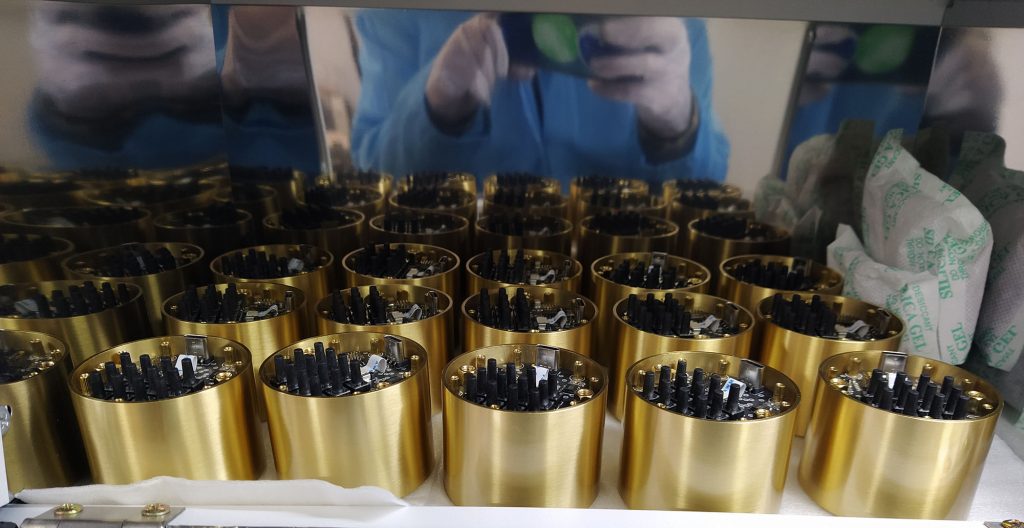
Other than showing prototypes to Kickstarter backers, we arranged an Engineering Verification Testing (EVT) for 125 units, sending free samples to (open) labs and potential users.
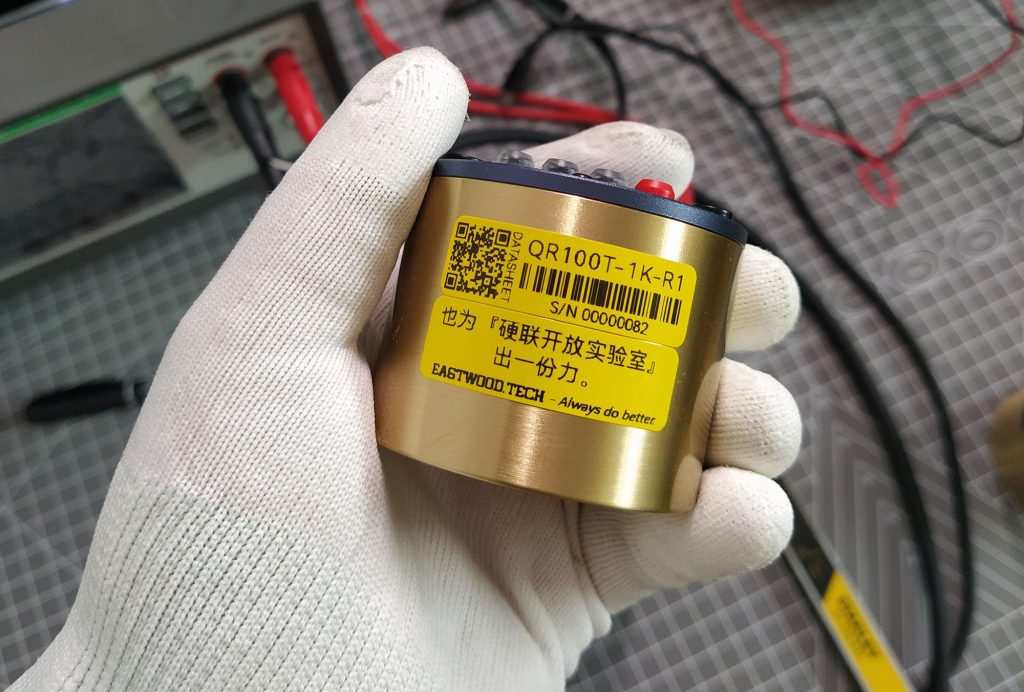
In fact, before this campaign we also did a small marketing test on Xianyu – a shopping APP by Alibaba for pre-owned goods. We sold out around 100 pcs QR10 test samples as “pre-owned” at a huge discount (about 50% off) and collected valuable feedback from the customers.
Our first customer whose nickname is “Bluedream”, he made a feature request of “output auto scanning”. It took us three days to implement it (without any additional charge). We decided to unlock this feature if we could reach 100 backers goal.
One of our customers told us using QR10 earned him praise from some members in their electronic hobbyist group. We still remember the day when orders were placed one after another – 8 orders in just one hour – a moment that made us more confident and proud of our product!

As of today, we have more than 60 users around mainland China and HK. They’re electronics enthusiasts (in Wuxi, Changchun, Shenzhen, Wuhan, Changsha,…), engineers (in Urumqi, Nanjing, Guangzhou, Dongguan,…), college students (in Beijing), professor (in Hangzhou), entrepreneurs(in Nanjing, Zhengzhou, Shanghai & HK) and even an engineer from Chinese Academy of Sciences (Beijing) who applauded QR10 as “a craft”.
Here are some some constructive feedback points gathered on how to improve QR10:
- The keycaps should not rotate – which can lead to the numerals upside down
- The output terminals (M2 banana plugs) are inconvenient
We have addressed these issues and are releasing the latest edition, Edition 3/3+, on Kickstarter.

Rewards
Eastwood Instruments was found by engineers, with engineers and for engineers. Our motto is to “make precision instruments smart & affordable”.
QR10 was designed with all our heart and soul. It’s an instrument specially for individuals such as makers, engineers, technicians, teachers and students. To make the world slightly better, we decided to provide a solid 30% OFF in this Kickstarter campaign. Freightage basically is not included, for that it ranges from $20 to $70 – a cost beyond our budget to waive.
Please refer to Kickstarter “rewards tiers” for more details.
Note-1: The weight of QR101 (including package and accessories) is approximate 0.4 kg, it might save your freightage if you order two more units(you can order more types or quantities by adding related add-ons to your shopping cart).
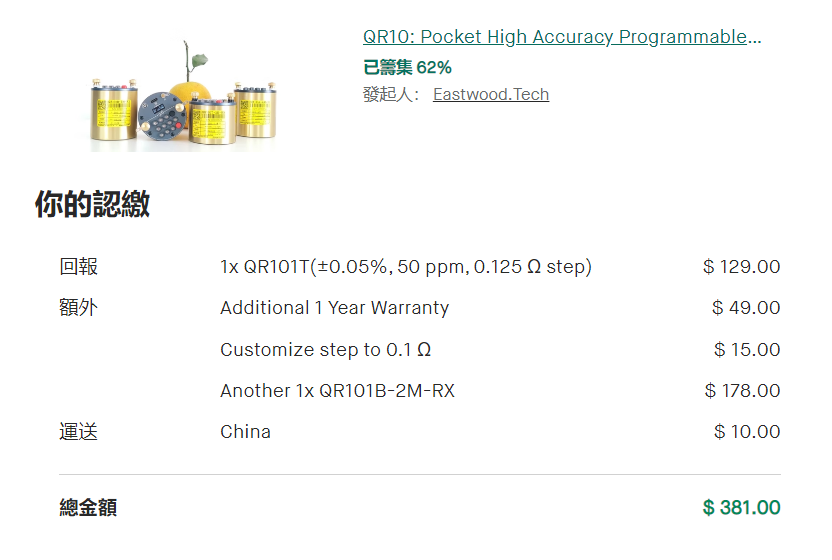
Note-2: For all the backers: prepayment of shipping given is an approximate number, so we’ll return the overcharged part and might ask you for the undercharged part.
Stretch Goals
- Level-1:Unlock “Auto-scan” function if there are more than 100 backers. – Adding this feature requires an MCU of larger flash size.

- Level-2: If we can reach the $50,000 funding goal, we’ll upgrade (part of) T/B class base resistors from 50 ppm to 25 ppm; upgrade (part of) A class base resistors from 25 ppm to 15 ppm / 10 ppm. – We cannot guarantee to upgrade all of the base resistors due to the fact that some of them are not common values. However, it is possible to customize higher grade base resistors at relatively lower price if we received sufficient demands.

Level-3: $100,000 funding will enable us to consider upgrading all the keycaps to Aluminum alloy (Edition 3+) – one more step towards “a craft”.
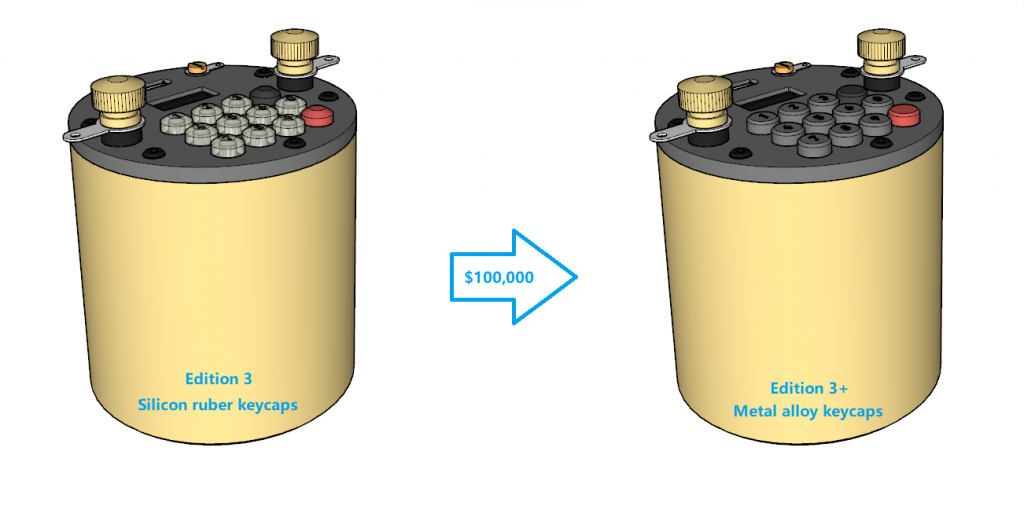
Timeline
- Apr. 2018 First version PCBA created in part time, using ceramic encased resistors.
- Sept. 2018 Second version PCBA created in part time, using wire wound resistors.
- Oct. 2018 Third version PCBA created in part time, choosing metal foil resistors and RF relays.
- Feb. 2020 DIY a low-cost resistance board by using DIP switch, with too much noise due to the unstable switch contact resistance.
- May 2021 Formed Eastwood Instruments team.
- Jun. 2021 Fourth version PCBA created in our lab, selected MELF resistors and latching RF relays.

- Dec. 2021 Design patent of QR10 industrial design.
- Jan. 2022 Utility patent of programmable resistor approach.
- Feb. 2022 EVT for 125 sets.
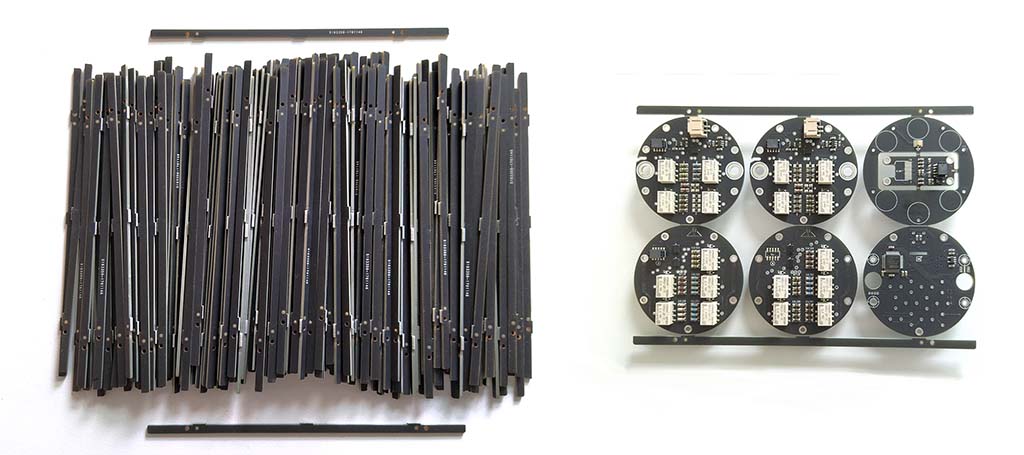
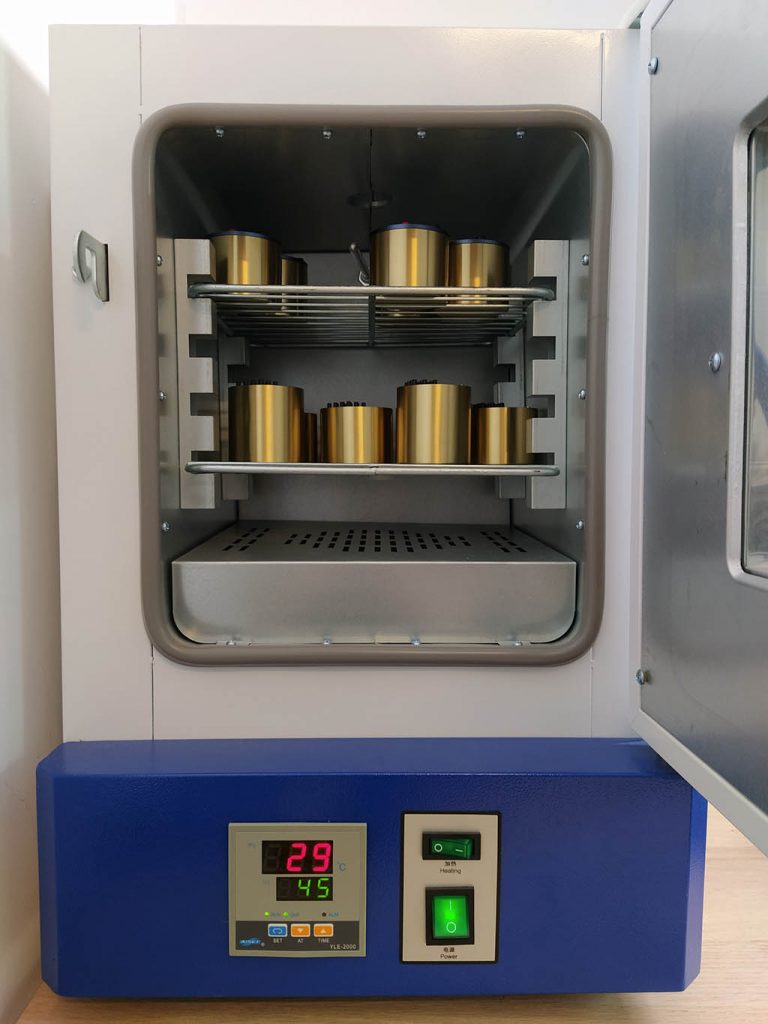
- Mar. 2022 Official website eastwood.tech opened to the public
- Mar. 2022 Shelter at home for one week due to COIVD-19
- Apr. 2022 Sending out free samples, donation to labs and did marketing test on Xianyu APP
- May 2022 Trial version released for elecfans.com
- Jun. 2022 Teardown video by independent third party on bilibili.com
- Jul. 2022 Launching our campaign on Kickstarter
- Shipping is planted in Oct. 2022 if all goes smoothly.
/*———————————————————
We need your help to bring QR10 EDITION 3/3+ to life.
———————————————————*/
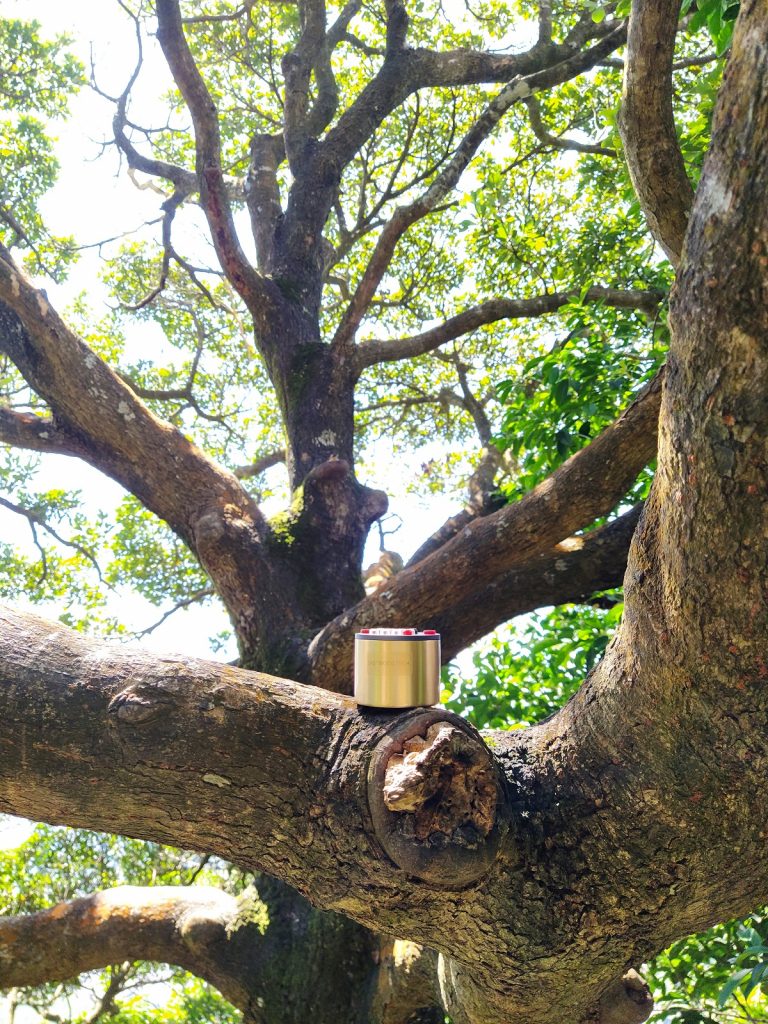
About Us
- Channing Chang – Founder of Eastwood Instruments. Graduated from SHNU with a major in Electrical Engineering and Automation. Working experience in OEM/ODM company and German instruments GmbH (as the leading R&D engineer). Designed, developed and evaluated the hardware, part of the firmware, mechanical structure and the industrial design of QR10.
- Frank Li – Co-founder of Eastwood Instruments. M.S. in Computer Science from UKy. Working experience in Silicon Valley as a Software Professional. Mainly in charge of firmware coding, North American marketing and sales.
- Nicky Lin – Business partner, engineer. Strong background in Electronic Manufacturing & Service (EMS) leading companies. Living in Taipei and joined Eastwood Instruments as a consultant, shares parts of R&D workload and takes care of mass production.
- Crystal Lee – Co-founder of Eastwood Instruments, investor. Manager of a multinational enterprise located in Shenzhen, mainly handling financial affairs. She also recommended using fast-growing wood as QR10 packaging.
Risks & Challenges
As we known, manufacturing an electronic product is complicated – and even more complicated for instruments. Luckily, we have went through the most difficult section. For the mass production and delivery, risks and challenges might be:
- Lack of ICs could be fatal for production, although we have already prepared some in stock.
- The output range of QR10 may slightly differ from the given range since we may choose different base resistors if the original ones are not available.
- Small changes of the design or improvements of the product may not inform our backers in time.
- Shipping may be affected by wars, extreme weather and local COVID-19 policies.
But no worry, we’ll figure out a way as always.
Environmental commitments
Long-lasting design
We enabled the calibration interface to users, so users can calibrate by themselves even if after changing the broken relays and/or base resistors.
Reusability and recyclability
We mainly select fast-growing wood and recyclable paper for packaging.
Sustainable materials
As for the product itself, we choose recyclable expensive metal alloy (brass and aluminum) as housing & lid instead of using plastic.
Environmentally friendly factories
We’ll select a PCB/SMT factory that can provide a RoHS compliant certificate.
Something else
Unlike consumer electronics, our products are designed to be stable and to provide long-term service. We hope our product could be a useful tool on your desktop or in your pocket during your career. You can even pass it down to your next generation if it works smoothly.
Click here back to our Kickstarter Campaign